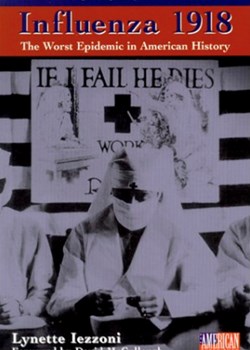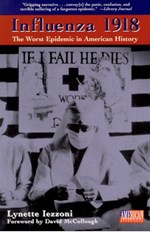Influenza 1918: The Worst Epidemic in American History
- Home
- World War I Book Reviews
- Influenza 1918: The Worst Epidemic in American History

Book review by Bill Hanigan.
[This review first appeared in the journal of The Western Front Association Stand To! Issue No.58 April 2000. This and other copies of the journal of The Western Front Association are available to read online to members by signing in using their Member Login]
The jacket of this book describes it as a companion to the documentary 'Influenza 1918' aired on PBS in the series The American Experience. This description is accurate. Using individual voices or vignettes, Lynette Iezzoni creates an evocative and surprisingly complete picture of the pandemic's effects on the American population. Information on the vagaries of medical care, public health and military responses and statistics in order to place the pandemic in perspective are interworked with descriptions of panic in the streets, coffin shortages and the occasional live burial. Ms. Iezzoni outlines pre-war bacteriological theory, the important but unsuccessful attempts at antiserum or vaccine therapies, clinical human research and the history and laboratory investigations of Bacillus influenzae first believed to be the causative organism of the pandemic. Perhaps the most important lessons are in the final two chapters, which review research since the war including Shope's work on the swine flu in Iowa and British isolation of the influenza virus in the early 30s. The author also describes recent investigations of molecular biologists who are attempting genetic characterisation of the 1918 virus from stored pathological specimens.
The author does not pursue medical or historical debate to any great extent, and there is very little new information here other than the various individuals' recollections of a bad time. The bibliography is sparse and the nature of scholarship reinforces older misconceptions. Camp Funson, Kansas may not have been a sanitary paradise but it is naive to implicate this location as the source of a global pandemic. This historical accusation implies a theory of pandemic spread that simply cannot be confirmed and much epidemiological data suggest otherwise.
Influenza was not the source of post-encephalic Parkensonism; that was another illness, another virus. The predilection of this virus for young adults may be challenged medically and epidemiologically. Although the mortality was high, the incidence was extraordinarily high; 80-90 per cent of patients suffered for a week and returned to their daily lives. This fact may be boring and not the stuff of popular history but should be taken into account.
Most patients died from a well- recognised secondary bacterial pneumonia, only 5-10 percent died from the primary influenzal infection. All in all, the review is mixed. For more experienced readers, this book may not be useful. For those not familiar with the 'Spanish Lady' it is a good start. The style is professional, the photographs are excellent and the price is right.
[There are over 1,650 articles and 2,000 book reviews in the archive of Stand To! Members receive the magazine three times a year, as well as our member magazine Bulletin. ]

Influenza 1918: The Worst Epidemic in American History.
Lynette Iezzoni
TV Books 1999
US$24.95.





